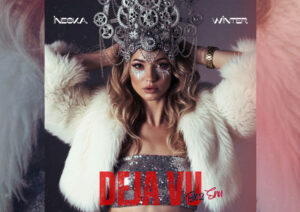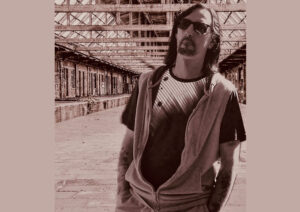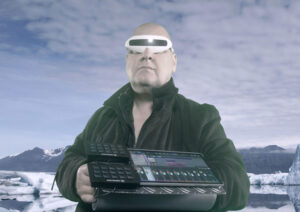INTERVIEW: How Horacio Powder Blends Music, Mental Health, and Minimalism
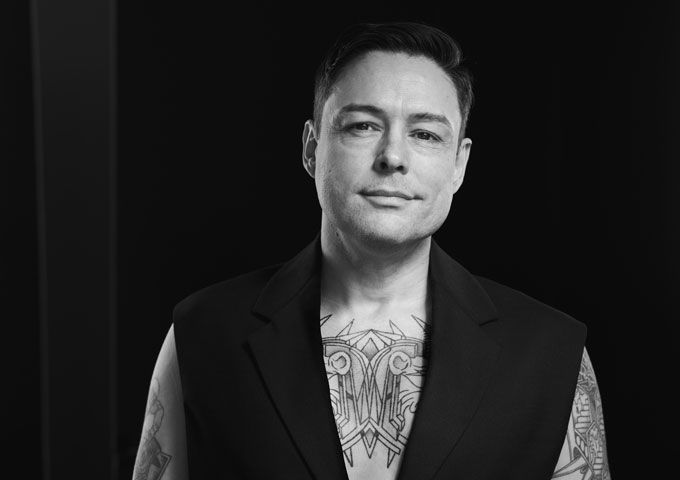
In the pulsating heart of Chicago’s techno scene, Horacio Powder stands as a beacon of creativity and purpose. Known for his deep passion for music, minimalism, mental health advocacy, and a love for cats, Horacio has crafted a distinct space in the electronic music world. His sound, inspired by the geometric elegance and boldness of Chicago’s iconic art deco architecture, combines sleek lines, luxurious textures, and modernity to create something truly unique. But there’s more to Horacio than just beats and rhythms. His work serves as a vessel for mental health awareness, offering listeners an emotional refuge. Through his sets, he opens up a sonic space where people can explore their inner worlds, reflecting on their well-being in a chaotic world. When Horacio isn’t shaping dancefloors, he draws inspiration from the quiet elegance of his feline companions, whose graceful simplicity mirrors the fluidity of his music. Much like a cat’s effortless movement, his music flows seamlessly, embodying his philosophy of minimalism—stripping away excess to reveal the raw beauty beneath. Horacio’s vision is clear: to show that in a world full of noise, simplicity can be the most powerful tool of expression. His artistry invites us all to pause, listen, and reconnect with what truly matters.
- “Obsidian” is your latest release. Can you take us through the creative process behind the EP? What inspired the dark, pulsating beats of the title track, and how does it reflect your current artistic vision?
Horacio Powder: The creative process for me begins with observing the world around me and using my senses to find sounds and rhythms that reflect what I am experiencing and the memories that I have formed from those experiences. Before I moved to Chicago I lived in desert in Yuma, Arizona and I spent a great deal of time combing through the hills in search of gems and minerals that are abundant in the area. I have spent many nights out in the great expansive darkness listening to the quiet sounds of the wind flowing over the terrain made up of sandstone and granite, through the sparse vegetation. It has a certain timbre that is hard to describe, but when you are actively listening to it there is a very rich soundscape that becomes apparent. I tried to capture the experience of walking through the desert at night, with darkness and starlight, the sound of the crunchy gravel beneath your feet and the whispers of desert animals off in the distance. Out in the desert near the Salton Sea there is a great deal of active geologic activity and there is a hill known as obsidian butte that is made of pure volcanic glass rising above a grid of carefully laid out asphalt roads and rows of crops that appear alien and artificial growing in the desert. The contrast between the natural world, and the machined symmetrical incursion of progress into it form the basis of my current artistic vision. The Art Deco movement seems to reflect this vision where machine made lines and structures collide with natural and decorative elements and so I like to think of my music as Art Deco Techno.
- You’ve described minimalism as both an aesthetic and a philosophy. How do you approach incorporating minimalism into your sound, especially in tracks like ‘Coriolis Effect,’ where there’s a balance between intricacy and simplicity?
Horacio Powder: When I think of minimalism in both thought and action, I think of leaving space open so that it can be filled with interpretation through the senses and mind. This means that I try to leave some space in the track so that it can be filled with reflection, feeling, and thought. This takes time, and I want to give the listener some space to think about what they just heard and meditate on it for a few seconds before moving to the next sound. This allows for the space to evoke memories and create new sensations and experiences that are unique for each listener. The Japanese concept of ma (間) is applicable here which is about negative or open space and time. I think that it is interesting that the kanji is formed by a gate, with the sun peering through. In this sense, I want to create gates in my music that are minimally represented so that the listener can go through them with their own thoughts and enlightenment coming out on the other side. There is also a functional side to this. I have been working for many years to be a live performance artist, previously having experimented with huge MIDI chains and lots of synthesizers and drum machines linked to a computer. Now with the technology that allows me to easily create hybrid sets I wanted to create tracks that leave room for other things such as improvisational synth work, live percussion, and instruments. Incorporating minimalism into the tracks gives me the freedom and space to explore what I am feeling in the moment during a live performance and express that in real time.
- Mental health advocacy is a significant part of your identity. How do you weave mental health themes into your music? Does ‘Obsidian’ reflect any personal or emotional journey related to this advocacy?
Horacio Powder: I believe that many people are struggling with serious mental health issues around the world and the impact of that is just overwhelming. I try to create music that accomplishes a few things that serve to improve the health and well being of the mind and body for the listener. The first is a shift away from musical keys and phrases that are dark, gothic, and tense. It seems like so much of techno music is obsessed with the dark and scary, as if it was the aural embodiment of a technological dystopian future that was born out of the capitalist forges that spawned robotic killing machines and artificial intelligences that would subjugate and destroy us. That is some extremely scary shit, and of course some of that is true. Music that makes us feel like we are living in a world that is being taken over by machines fuels our anxiety and creates tension that drives us to behave in unhealthy ways. To combat that anxiety people turn to substance abuse and excess to cope with the pressure, to submit to it, to embrace it. While I am a huge fan of shadow work, I feel like there must be a balance to the dark side that allows us to feel optimistic and in control of our lived experience so I am working to focus on musical keys, chords, and melodies that bring us out of the darkness of a technological revolution and into the progress and optimism of a future where technology is balanced harmoniously with the natural world to enhance our lives. I seek to take techno and use it to create soundscapes that are both structured and uplifting. Using meditative rhythms, healing tones, balance, clarity, and symmetry make me feel grounded and at ease, with a vitality and energy that relieve my anxieties and depressive urges.
- Your music draws inspiration from the art deco movement, especially its geometric elegance and bold lines. How does that architectural influence shape the sonic textures and structure of your productions on ‘Obsidian’ and in your broader work?
Horacio Powder: Art Deco was defined well after the movement itself by British art historian Bevis Hillier in a book that he wrote in 1968 on the decorative art movement of the 1920’s and 1930’s. If you look back at that period, it was the beginning of a technological revolution where machines were used in the manufacture of everything from buildings to textiles, home appliances, vehicles, and interiors. The machines made it possible to create perfectly straight and symmetrical lines that were then arranged geometrically into patterns. This was the foundation of the aesthetic, but it did not completely divorce itself from the previous art nouveau styling and decorative elements like flowers, birds, and foliage. Instead, it incorporated little bits of these elements into the design, juxtaposing the machine made with the natural world in a way that demonstrated that progress and technology could be interwoven together with the pastoral and exotic. Motifs were created based on things that were popular in culture at the time, such as Egyptian art, jungle animals, and mythological creatures. One of the more prominent elements in the architecture of the era was the ziggurat, or pyramid where a very thick and solid base forms the foundation for upward lines reaching into the sky, forming increasingly skyward layers that make the entire structure seem like it reaches into the heavens. In this way I like to structure my work with a heavy foundation of bass, and an intricate structure of percussion that holds together the various decorative sonic elements. I like to think of each track as a complete building with a foundation, structure, interior and exterior decoration, lighting, and the people that fill those spaces. This inspiration is directly taken from buildings in Chicago, Los Angeles, New York, London, and elsewhere where all of these elements come together to create a vibe or scene.
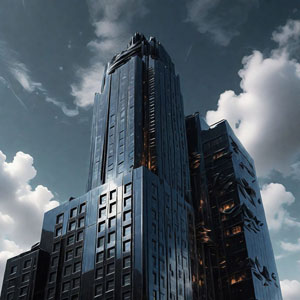
- You’ve mentioned that cats are a source of inspiration in your life. Can you talk about how your feline companions influence your creativity, and do they play any role in the mood or flow of the ‘Obsidian’ EP?
Horacio Powder: Cats are incredible creatures and I could go on and on about how they are able to do things like survive in harsh climates, drink sea water, and be both efficient predators and fearful prey at the same time. It is absolutely fascinating from a biological perspective and my cats have taught me a great deal about things like perception, anxiety, stillness, patience, playfulness, and vibrations. I could go on and on about the relationship that I have with my three cats, Dinky, Dusty, and Oregano but I will spare you the details of kitty life and focus on the question about Obsidian. Yes, they do play a role in the mood and flow of the song because in the track there is an almost cat like build up to where the percussion comes in. The track starts quietly, stalking the listener with rotating ears picking out the slightest changes in sound and motion, moving closer to the target in a smooth and silky way until the inevitable pounce. I actually like to play with sound design so that my cats become interested in what I am doing and I know that I am on the right track when all three of them perch themselves up on their posts and sit listening to the soundscapes with ever moving ears. They are sensitive to sounds like bird chirps, scratching, breathing, and textural elements and surprisingly they seem to be fascinated by the harmonica which I hope to incorporate into future tracks.
- The Chicago techno scene is rich with history. How has the city and its musical culture shaped your sound, and what role does it play in shaping the themes of your latest EP?
Horacio Powder: One of the great things about Chicago is the generational appreciation of house music, and electronic music in general. There is a great festival and club scene, but beyond that I am impressed with the way that electronic music in some form is found at street fairs, public events, and even in places that you wouldn’t expect like train stations. The music is all around, and so I feel like it is a part of the city. This shapes what I do because I’m taking it all in and thinking about a sound that is not only rooted in the architecture and design of the city, but the people and culture.
- ‘Obsidian’ is a powerful title, often associated with volcanic glass and deep, reflective darkness. What significance does the name hold for you, and how does it relate to the overall vibe of the track?
Horacio Powder: The significance is less about what obsidian represents, and more about the substance itself. It was used as a building block or a tool all the way back in ancient times as it was used to make arrowheads, spearheads, and cutting tools. I think of my tracks as tools that help to shape and form the overall experience for the listener in my sets. To me, “Obsidian” is the dark substance that came out of the earth’s core, and I would use it to bring that feeling.
- ‘Coriolis Effect’ has an intriguing title, referencing a phenomenon that affects motion across rotating systems. Is there a conceptual or metaphorical connection between this scientific idea and the music itself?
Horacio Powder: When I created the track I was thinking about swirling winds and weather patterns like tornados because these are a very real thing here in Chicago. I will never forget my first tornado warning, which was a terrifying even with sirens blaring all over the city and then the thunder and wind. The way that it swirled and whipped through the tall buildings downtown and the sounds that it made were the inspiration for the track. I tried to sonically capture some of those sounds, or at least some abstract representation of them. Like objects, caught up in the spinning forces being affected by many other moving systems. I was thinking about all of the spirals and curves, and I was reminded of the Coriolis effect which is something that to be honest I don’t fully understand.
- How do you balance creating a sense of emotional depth and connection in your music while still keeping the sound rooted in minimalism and techno’s hypnotic, driving energy?
Horacio Powder: I think that emotional connection can be drawn from the experience if you leave the space open for it. Quite a bit of music tells you exactly how you should feel when you are experiencing it, and what I seek to do is remove as much of the emotional sentiment from my music as I can so that the minimally constructed chords and melodies, combined with the hypnotic and driving energy allow the listener to transcend into their own meditative space where they can find their own emotional connection to what they are experiencing. It works this way in abstract art where the feeling that a person gets from looking at it is their own, it is not proscribed for them by the artist. I want people to experience my music and be transported to a place that is unique to them, with the associated feeling and emotions that are unique to them as well.
- Your live sets are described as sonic journeys that transcend boundaries. When performing tracks like those on ‘Obsidian,’ how do you aim to guide listeners on an emotional or mental exploration?
Horacio Powder: I honestly feel like each set should be a journey and I like to think of my sets like a hike. You start out slow and flat, gradually gaining elevation until you reach a challenging peak. When you make it to the peak, you take some time to look around and get a full view of things from a different perspective. Then, you gradually begin the descent back to the ground or starting point. I think that sets that are generally flat or bumpy don’t really bring the listener’s awareness through different perspectives. I like to help the listener explore different moods and feelings just like you would if you went on a long hike through the mountains, desert, or even into the Grand Canyon where there are so many layers to experience as you go in, just like the geologic layers that surround you.
- Art deco is known for its luxurious, modern textures. How do you translate those visual aesthetics into sound, especially on your recent tracks? What’s the process of making music that feels both elegant and bold?
Horacio Powder: The art deco aesthetic is full of both the bold and the elegant. I created a style guide for myself that incorporates the ideas behind the architecture, interior design, and fashion and it begins with some of the bold elements that you find in the buildings. I construct the track like an architect constructs a building. I start with the foundation and structure, then I add the interior and exterior, and finally I fill the space with lighting, decorations, and people. The drums and bass form the foundation and structure, with synths and samples adding the other elements as the track is constructed. I think that being in Chicago has really given me the opportunity to see what this looks like visually as the city is just full of art deco architecture and design. My job is to take what I see all around me and turn it into soundscapes and rhythms.
- Looking forward, how do you see your sound evolving after ‘Obsidian’? Are there any new themes, concepts, or styles you’re eager to explore in your future projects?
Horacio Powder: Moving forward I would like to continue to take inspiration from the urban and natural world and combine those elements conceptually into my tracks. Obsidian was the product of my experiences out in the desert at Obsidian Butte merging with my experiences in the big city where I came face to face with the Carbide and Carbon building, an art deco masterpiece that is covered in polished black granite so it looks like a big obsidian crystal rising into the sky. I want to continue with this theme of progress and industrialism combined with the natural world in a harmonious way. I would also like to take a cue from the art deco era and incorporate more decorative sonic elements that represent some of the ancient art that is found in many of the motifs, such as Egyptian or Mesoamerican art. I am not exactly sure how that would sound, but I have a good workflow and some great ideas to build upon in the future.
OFFICIAL LINKS: https://linktr.ee/horacio_powder




